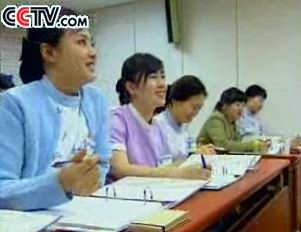Source: CCTV.com
01-25-2007 18:36
Imagine a factory, operating around the clock, with no breaks and where workers do not appear to be tired. This has been made possible with a system using four groups and two shifts. It's currently being used in a South Korean factory. In today's Working Asia series, Kim, Y.S from South Korea's Educational Broadcasting System has a look at how this system works.
The innovative work system employed by this factory is one face of the so-called “New Paradigm.” Work time is reduced but more workers are hired, and this gives the laborers a chance to learn more and train better. In turn, this maximizes operation time while producing fewer defective goods. In 1998, when Korea was struggling to rebuild under the terms of the IMF bailout, labor and management agreed on this shift system to share work spots instead of resorting to lay-offs.
Factory manager M.S.Song said "Operational capacity had gone down 30% when foreign capital began pouring in. We had too many people, but after talking with the labor union, we found a way for them to all work together."
 |
The high cost of wages and educational training made it a difficult decision. Labor costs shot up 34% at first, a major budget issue, but in the end it turned out to be a very profitable decision.
Song said "We now have a system where people can rest and relax while the factory is still running. We operate at high capacity, and our productivity has led to high profits, despite the high wage costs at the beginning."
The company once made around US$40 million, but after employing the New Paradigm, profits shot up to over $90 million, and with fewer workplace injuries. Because of these positive results, the New Paradigm is being touted as a new model for Korean companies, bringing the promise of greater profits and increased productivity, while work hours actually decrease.
Director of New Paradigm Center B.H.Shin said "The New Paradigm enables workers to better themselves individually. They became better educated, which improves the company’s pool of skills. This leads to a greater competitive edge, and that is good for the country."
Although their pay remains the same, the workload shrinks to forty hours a week, twenty less than before. The employees are excited by this prospect.
Nurse S.Y.Kim said "What I like most is that I now have time to learn and enjoy myself."
Under the New Paradigm, the dental clinic will run until 10 p.m., and it stays open on weekends and holidays. This provides not only reduces the wage burden, but it also provides greater convenience for patients with busy schedules. The best benefit, however, is that the workers are able to receive specialized education to make their clinic more competitive through better service and cutting-edge techniques.
Dentist Y.H.Shin said “New techniques and equipment are produced everyday. We want to go in the direction where 50% of the time is spent working and 50% is spent learning.”
The New Paradigm is a new wave brining a better work environment, more job positions, and enhanced productivity. A new solution to the challenges facing the Korean economy.
In tomorrow's Working Asia series, Mohammad Reza Dehshiri from Islamic Republic of Iran Broadcasting brings you stories about blind workers in Iran.
Editor:Du Xiaodan
